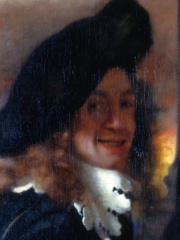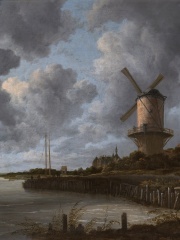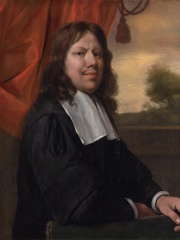







The Most Famous
PAINTERS from Netherlands
This page contains a list of the greatest Dutch Painters. The pantheon dataset contains 2,023 Painters, 155 of which were born in Netherlands. This makes Netherlands the birth place of the 5th most number of Painters behind United States, and Germany.
Top 10
The following people are considered by Pantheon to be the top 10 most legendary Dutch Painters of all time. This list of famous Dutch Painters is sorted by HPI (Historical Popularity Index), a metric that aggregates information on a biography's online popularity. Visit the rankings page to view the entire list of Dutch Painters.

1. Vincent van Gogh (1853 - 1890)
With an HPI of 93.26, Vincent van Gogh is the most famous Dutch Painter. His biography has been translated into 211 different languages on wikipedia.
Vincent Willem van Gogh (Dutch: [ˈvɪnsɛnt ˈʋɪləɱ vɑŋ ˈɣɔx] ; 30 March 1853 – 29 July 1890) was a Dutch Post-Impressionist painter who is among the most famous and influential figures in the history of Western art. In just over a decade, he created approximately 2,100 artworks, including around 860 oil paintings, most of them in the last two years of his life. His oeuvre includes landscapes, still lifes, portraits, and self-portraits, most of which are characterised by bold colours and dramatic brushwork that contributed to the rise of expressionism in modern art. Van Gogh's work was only beginning to gain critical attention before his death from suicide at age 37. During his lifetime, only one of Van Gogh's paintings, The Red Vineyard, was sold. Born into an upper-middle-class family, Van Gogh drew as a child and was serious, quiet and thoughtful, but showed signs of mental instability. As a young man, he worked as an art dealer, often travelling, but became depressed after he was transferred to London. He turned to religion and spent time as a missionary in southern Belgium. Later he drifted into ill-health and solitude. He was keenly aware of modernist trends in art and, while back with his parents, took up painting in 1881. His younger brother, Theo, supported him financially, and the two of them maintained a long correspondence. Van Gogh's early works consist of mostly still lifes and depictions of peasant labourers. In 1886, he moved to Paris, where he met members of the artistic avant-garde, including Émile Bernard and Paul Gauguin, who were seeking new paths beyond Impressionism. Frustrated in Paris and inspired by a growing spirit of artistic change and collaboration, in February 1888 Van Gogh moved to Arles in southern France to establish an artistic retreat and commune. Once there, his paintings grew brighter and he turned his attention to the natural world, depicting local olive groves, wheat fields and sunflowers. Van Gogh invited Gauguin to join him in Arles and eagerly anticipated Gauguin's arrival in late 1888. Van Gogh suffered from psychotic episodes and delusions. He worried about his mental stability, and often neglected his physical health, did not eat properly and drank heavily. His friendship with Gauguin ended after a confrontation with a razor when, in a rage, he mutilated his left ear. Van Gogh spent time in psychiatric hospitals, including a period at Saint-Rémy. After he discharged himself and moved to the Auberge Ravoux in Auvers-sur-Oise near Paris, he came under the care of the homeopathic doctor Paul Gachet. His depression persisted, and on 29 July 1890 Van Gogh died from his injuries after shooting himself in the chest with a revolver. Van Gogh's work began to attract critical artistic attention in the last year of his life. After his death, his art and life story captured public imagination as an emblem of misunderstood genius, due in large part to the efforts of his widowed sister-in-law Johanna van Gogh-Bonger. His bold use of colour, expressive line and thick application of paint inspired avant-garde artistic groups like the Fauves and German Expressionists in the early 20th century. Van Gogh's work gained widespread critical and commercial success in the following decades, and he has become a lasting icon of the romantic ideal of the tortured artist. Today, Van Gogh's works are among the world's most expensive paintings ever sold. His legacy is celebrated by the Van Gogh Museum in Amsterdam, which holds the world's largest collection of his paintings and drawings.

2. Rembrandt (1606 - 1669)
With an HPI of 90.59, Rembrandt is the 2nd most famous Dutch Painter. His biography has been translated into 175 different languages.
Rembrandt Harmenszoon van Rijn (; Dutch: [ˈrɛmbrɑnt ˈɦɑrmə(n)ˌsoːɱ vɑn ˈrɛin] ; 15 July 1606 – 4 October 1669), mononymously known as Rembrandt, was a Dutch Golden Age painter, printmaker, and draughtsman. He is generally considered one of the greatest visual artists in the history of Western art. It is estimated that Rembrandt's surviving works amount to about three hundred paintings, three hundred etchings, and several hundred drawings. Unlike most Dutch painters of the 17th century, Rembrandt's works depict a wide range of styles and subject matter, from portraits and self-portraits to landscapes, genre scenes, allegorical and historical scenes, biblical and mythological subjects and animal studies. His contributions to art came in a period that historians call the Dutch Golden Age. Rembrandt never went abroad, but was considerably influenced by the work of the Italian Old Masters and Dutch and Flemish artists who had studied in Italy. After he achieved youthful success as a portrait painter, Rembrandt's later years were marked by personal tragedy and financial hardships. Yet his etchings and paintings were popular throughout his lifetime, his reputation as an artist remained high, and for twenty years he taught many important Dutch painters. Rembrandt's portraits of his contemporaries, self-portraits and illustrations of scenes from the Bible are regarded as his greatest creative triumphs. His approximately 40 self-portraits form an intimate autobiography.

3. Johannes Vermeer (1632 - 1675)
With an HPI of 87.28, Johannes Vermeer is the 3rd most famous Dutch Painter. His biography has been translated into 107 different languages.
Johannes Vermeer ( vər-MEER, vər-MAIR, Dutch: [joːˈɦɑnəs fərˈmeːr]; see below; also known as Jan Vermeer; October 1632 – 15 December 1675) was a Dutch painter who specialized in domestic interior scenes of middle-class life. He is considered one of the greatest painters of the Dutch Golden Age. During his lifetime, he was a moderately successful provincial genre painter, recognized in Delft and The Hague. He produced relatively few paintings, primarily earning his living as an art dealer. He was not wealthy; at his death, his wife was left in debt. Vermeer worked slowly and with great care, and frequently used very expensive pigments. He is particularly renowned for making masterful use of light in his work. "Almost all his paintings", Hans Koningsberger wrote, "are apparently set in two smallish rooms in his house in Delft; they show the same furniture and decorations in various arrangements and they often portray the same people, mostly women." The modest celebrity he enjoyed during his life gave way to obscurity after his death. He was barely mentioned in Arnold Houbraken's major source book on 17th-century Dutch painting (Grand Theatre of Dutch Painters and Women Artists, published 1718) and, as a result, was omitted from subsequent surveys of Dutch art for nearly two centuries. In the 19th century, Vermeer was rediscovered by Gustav Friedrich Waagen and Théophile Thoré-Bürger, who published an essay attributing 66 works to him, although only 34 paintings are universally attributed to him today. Since that time, Vermeer's reputation has grown enormously.

4. Piet Mondrian (1872 - 1944)
With an HPI of 84.15, Piet Mondrian is the 4th most famous Dutch Painter. His biography has been translated into 73 different languages.
Pieter Cornelis Mondriaan (Dutch: [ˈpitər kɔrˈneːlɪs ˈmɔndrijaːn]; 7 March 1872 – 1 February 1944), known after 1911 as Piet Mondrian (, US also ; Dutch: [pit ˈmɔndrijɑn]), was a Dutch painter and art theoretician who is regarded as one of the greatest artists of the 20th century. He was one of the pioneers of 20th-century abstract art, as he changed his artistic direction from figurative painting to an increasingly abstract style, until he reached a point where his artistic vocabulary was reduced to simple geometric elements. Mondrian's art was highly utopian and was concerned with a search for universal values and aesthetics. He proclaimed in 1914: "Art is higher than reality and has no direct relation to reality. To approach the spiritual in art, one will make as little use as possible of reality, because reality is opposed to the spiritual. We find ourselves in the presence of an abstract art. Art should be above reality, otherwise it would have no value for man." He was a contributor to the De Stijl art movement and group, which he co-founded with Theo van Doesburg. He evolved a non-representational form which he termed Neoplasticism. This was the new 'pure plastic art' which he believed was necessary in order to create 'universal beauty'. To express this, Mondrian eventually decided to limit his formal vocabulary to the three primary colors (red, blue, and yellow), the three primary values (black, white, and gray), and the two primary directions (horizontal and vertical). Mondrian's arrival in Paris from the Netherlands in 1912 marked the beginning of a period of profound change. He encountered experiments in Cubism and with the intent of integrating himself within the Parisian avant-garde removed an 'a' from the Dutch spelling of his name (Mondriaan).

5. Hieronymus Bosch (1450 - 1516)
With an HPI of 83.79, Hieronymus Bosch is the 5th most famous Dutch Painter. His biography has been translated into 85 different languages.
Hieronymus Bosch (; Dutch: [ɦijeːˈroːnimʏz ˈbɔs] ; born Jheronimus van Aken [jeːˈroːnimʏs fɑn ˈaːkə(n)]; c. 1450 – 9 August 1516) was a Dutch painter from Brabant. He is one of the most notable representatives of the Early Netherlandish painting school. His work, generally oil on oak wood, mainly contains fantastic illustrations of religious concepts and narratives. Within his lifetime, his work was collected in the Netherlands, Austria, and Spain, and widely copied, especially his macabre and nightmarish depictions of hell. Little is known of Bosch's life, though there are some records. He spent most of it in the town of 's-Hertogenbosch, where he was born in his grandfather's house. The roots of his forefathers are in Nijmegen and Aachen (reflected in his surname, Van Aken). His original, fantastical style cast a wide influence on northern art of the 16th century; Pieter Bruegel the Elder was his best-known follower. Today, Bosch is seen as a highly individualistic artist who offered profound insights into humanity's desires and deepest fears. Attribution of his work has been especially difficult; today only about 25 paintings are confidently given to his hand along with eight drawings. About another half-dozen paintings are confidently attributed to his workshop. His most acclaimed works consist of three triptych altarpieces, particularly The Garden of Earthly Delights.

6. Pieter Bruegel the Elder (1525 - 1569)
With an HPI of 83.58, Pieter Bruegel the Elder is the 6th most famous Dutch Painter. His biography has been translated into 83 different languages.
Pieter Bruegel (also Brueghel or Breughel) the Elder ( BROY-gəl, US also BROO-gəl; Dutch: [ˈpitər ˈbrøːɣəl] ; c. 1525–1530 – 9 September 1569) was among the most significant artists of Dutch and Flemish Renaissance painting, a painter and printmaker, known for his landscapes and peasant scenes (so-called genre painting); he was a pioneer in presenting both types of subject as large paintings. He was a formative influence on Dutch Golden Age painting and later painting in general in his innovative choices of subject matter, as one of the first generation of artists to grow up when religious subjects had ceased to be the natural subject matter of painting. He also painted no portraits, the other mainstay of Netherlandish art. After his training and travels to Italy, he returned in 1555 to settle in Antwerp, where he worked mainly as a prolific designer of prints for the leading publisher of the day. At the end of the 1550s, he made painting his main medium, and all his famous paintings come from the following period of little more than a decade before his early death in 1569, when he was probably in his early forties. In the 20th and 21st centuries, Bruegel's works have inspired artists in both the literary arts and in cinema. His painting Landscape with the Fall of Icarus, now thought only to survive in copies, is the subject of the final lines of the 1938 poem "Musée des Beaux Arts" by W. H. Auden. Russian film director Andrei Tarkovsky refers to Bruegel's paintings in his films several times, including Solaris (1972) and Mirror (1975). Director Lars von Trier also uses Bruegel's paintings in his film Melancholia (2011). In 2011, the film The Mill and the Cross was released featuring Bruegel's The Procession to Calvary.

7. Jacob van Ruisdael (1628 - 1682)
With an HPI of 75.72, Jacob van Ruisdael is the 7th most famous Dutch Painter. His biography has been translated into 44 different languages.
Jacob Isaackszoon van Ruisdael (Dutch pronunciation: [ˈjaːkɔp fɑn ˈrœyzdaːl] ; c. 1629 – 10 March 1682) was a Dutch painter, draughtsman, and etcher. He is generally considered the pre-eminent landscape painter of the Dutch Golden Age, a period of great wealth and cultural achievement when Dutch painting became highly popular. Prolific and versatile, Ruisdael depicted a wide variety of landscape subjects. From 1646 he painted Dutch countryside scenes of remarkable quality for a young man. After a trip to Germany in 1650, his landscapes took on a more heroic character. In his late work, conducted when he lived and worked in Amsterdam, he added city panoramas and seascapes to his regular repertoire. In these, the sky often took up two-thirds of the canvas. In total he produced more than 150 Scandinavian views featuring waterfalls. Ruisdael's only registered pupil was Meindert Hobbema, one of several artists who painted figures in his landscapes. Hobbema's work has at times been confused with Ruisdael's. Ruisdael always spelt his name thus: Ruisdael, not Ruysdael. Ruisdael's work was in demand in the Dutch Republic during his lifetime. Today it is spread across private and institutional collections around the world; the National Gallery in London, the Rijksmuseum in Amsterdam, and the Hermitage Museum in St. Petersburg hold the largest collections. Ruisdael shaped landscape painting traditions worldwide, from the English Romantics to the Barbizon school in France, and the Hudson River School in the US, and influenced generations of Dutch landscape artists.

8. Jan Steen (1626 - 1679)
With an HPI of 74.10, Jan Steen is the 8th most famous Dutch Painter. His biography has been translated into 50 different languages.
Jan Havickszoon Steen (c. 1626 – buried 3 February 1679) was a Dutch Golden Age painter, one of the leading genre painters of the 17th century. His works are known for their psychological insight, sense of humour and abundance of colour. Their satire also mocks the behavior and attitudes of the Dutch bourgeoisie.

9. Theo van Gogh (1857 - 1891)
With an HPI of 72.99, Theo van Gogh is the 9th most famous Dutch Painter. His biography has been translated into 39 different languages.
Theodorus "Theo" van Gogh (Dutch: [teːjoːˈdoːrʏs ˈteːjoː vɑŋ ˈɣɔx]; 1 May 1857 – 25 January 1891) was a Dutch art dealer and a younger brother of Vincent van Gogh. His support of his older brother's artistic ambitions and well-being allowed Vincent to devote himself entirely to painting. As an art dealer, Van Gogh played a crucial role in introducing contemporary French art to the public. Van Gogh died at the age of 33, six months after his brother's death at age 37. Van Gogh owned almost all of his brother's artwork. His widow, Johanna van Gogh-Bonger, worked to promote the work of Vincent and keep the memory of her husband alive. In 1914, Van Gogh's remains were buried next to those of his brother Vincent.

10. Pieter de Hooch (1629 - 1684)
With an HPI of 72.19, Pieter de Hooch is the 10th most famous Dutch Painter. His biography has been translated into 40 different languages.
Pieter Hendricksz. de Hooch (Dutch: [ˈpitər ˈɦɛndrɪksoːn də ˈɦoːx]; also spelled Hoogh or Hooghe; bapt. 20 December 1629 – after 1683), was a Dutch Golden Age painter famous for his genre works of quiet domestic scenes with an open doorway. He was a contemporary, in the Delft Guild of St. Luke, of Jan Vermeer with whom his work shares themes and style. De Hooch was first recorded in Delft on 5 August 1652, when he and another painter, Hendrick van der Burgh witnessed the signing of a will. He was active in 1683, but his date of death is unknown (his son Pieter died in 1684, a date often wrongly given for the father).
People
Pantheon has 155 people classified as Dutch painters born between 1410 and 1924. Of these 155, none of them are still alive today. The most famous deceased Dutch painters include Vincent van Gogh, Rembrandt, and Johannes Vermeer.
Deceased Dutch Painters
Go to all RankingsVincent van Gogh
1853 - 1890
HPI: 93.26
Rembrandt
1606 - 1669
HPI: 90.59
Johannes Vermeer
1632 - 1675
HPI: 87.28
Piet Mondrian
1872 - 1944
HPI: 84.15
Hieronymus Bosch
1450 - 1516
HPI: 83.79
Pieter Bruegel the Elder
1525 - 1569
HPI: 83.58
Jacob van Ruisdael
1628 - 1682
HPI: 75.72
Jan Steen
1626 - 1679
HPI: 74.10
Theo van Gogh
1857 - 1891
HPI: 72.99
Pieter de Hooch
1629 - 1684
HPI: 72.19
Han van Meegeren
1889 - 1947
HPI: 71.91
Dieric Bouts
1415 - 1475
HPI: 71.59
Overlapping Lives
Which Painters were alive at the same time? This visualization shows the lifespans of the 25 most globally memorable Painters since 1700.



